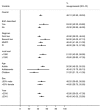HIV viral resuppression following an elevated viral load: a systematic review and meta-analysis
- PMID: 31746541
- PMCID: PMC6864498
- DOI: 10.1002/jia2.25415
HIV viral resuppression following an elevated viral load: a systematic review and meta-analysis
Abstract
Introduction: Guidelines for antiretroviral therapy recommend enhanced adherence counselling be provided to individuals with an initial elevated viral load before making a decision whether to switch antiretroviral regimen. We undertook this systematic review to estimate the proportion of patients with an initial elevated viral load who resuppress following enhanced adherence counselling.
Methods: Two databases and two conference abstract sites were searched from January 2012 to October 2019 for studies reporting the number of patients with an elevated viral load whose viral load was undetectable when subsequently assessed. Data were pooled using random effects meta-analysis.
Results: Fifty-eight studies reported outcomes of 45,720 viraemic patients, mostly from Africa (48 studies), and among patients on first-line antiretroviral therapy (43 studies). Almost half (46.1%, 95% CI 42.6% to 49.5%) of patients with an initial elevated viral load resuppressed following an enhanced adherence intervention. Of those on first-line ART with confirmed virological failure (6280 patients, 21 studies), only 53.4% (40.1% to 66.8%) were appropriately switched to a different regimen. Resuppression was higher among studies that provided details of adherence support. The proportion resuppressing was lower among children (31.2%, 21.1% to 41.3%) and adolescents (40.4%, 15.7% to 65.2%) compared to adults (50.4%, 42.6% to 58.3%). No important differences were observed by date of study publication, gender, viral failure threshold, publication status, time between viral loads or treatment regimen. Information on resistance testing among people with an elevated viral load was inconsistently reported.
Conclusions: The findings of this review suggest that in settings with limited resources, current guideline recommendations to provide enhanced adherence counselling can result in resuppression of a substantial number of these patients, avoiding unnecessary drug regimen changes. Appropriate action on viral load results is limited across a range of settings, highlighting the importance of viral load cascade analyses to identify gaps and focus quality improvement to ensure that action is taken on the results of viral load testing.
Keywords: adherence; elevated viral load; enhanced adherence counselling; viral resuppression; viral suppression.
© 2019 The Authors. Journal of the International AIDS Society published by John Wiley & Sons Ltd on behalf of the International AIDS Society.
Figures
References
-
- World Health Organization . Consolidated guidelines on the use of antiretroviral drugs for treating and preventing HIV infection: recommendations for a public health approach, 2nd edn Geneva: WHO; 2016. - PubMed
-
- Lejone TI, Ringera I, Cheleboi M, et al. The treatment cascade in children with unsuppressed viral load‐a reality check in Rural Lesotho, Southern Africa. J Acquir Immune Defic Syndr. 2018;77(3):250–6. - PubMed
-
- MSF . Making viral load routine. Successes and challenges in the implementation of routine HIV viral load monitoring. 2016. Available from: https://www.msf.org/sites/msf.org/files/making_viral_load_routine_part_1.... Accessed 7 November 2019
Publication types
MeSH terms
Substances
Grants and funding
LinkOut - more resources
Full Text Sources
Medical



